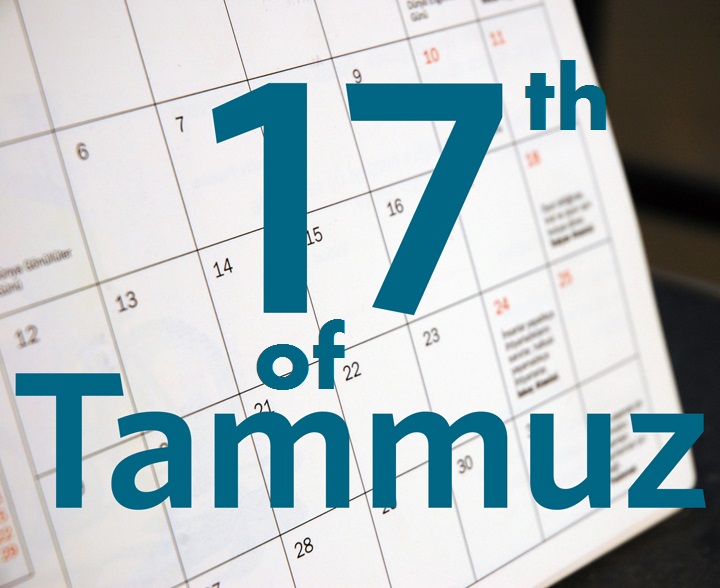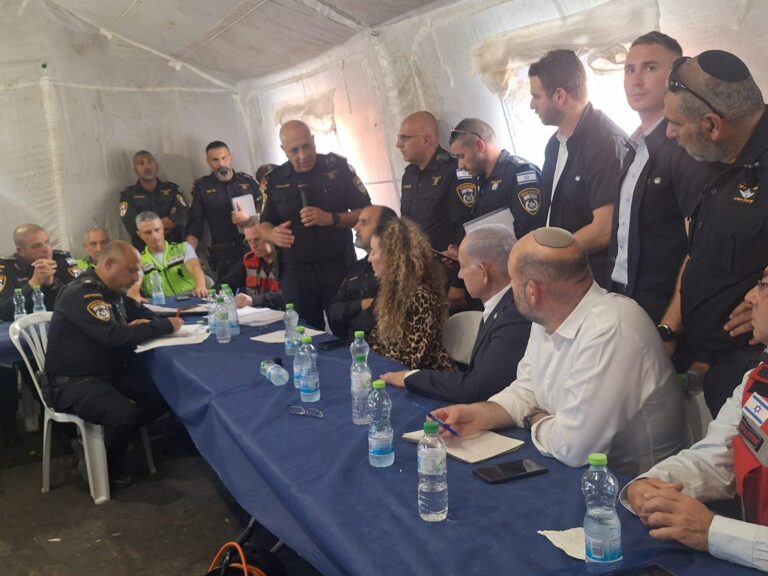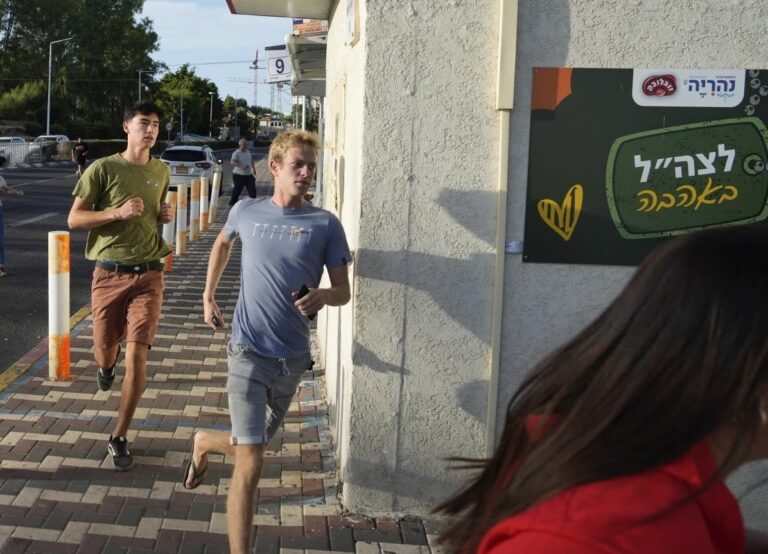by Rabbi Yair Hoffman for 5tjt.com
Although the Three Weeks and the other two fasts are a period of mourning and introspection, Zechariah the Navi tells us (Zechariah 8:19) that eventually, the four fasts of Klal Yisroel will be a source of joy and gladness — if we but embark upon the goal of loving both truth and shalom. These two themes are central to Torah life. Rabbi Chaninah tells us (Shabbos 55a) that Hashem’s seal is truth. Shalom is also one of the names of Hashem, in addition to being a central theme of our daily Tefilos. If we learn to love these ideals — the fasts will be turned around.
The four fasts mentioned in Zechariah are:
- The fast of the fourth month. [Tamuz – the 17th of it]
- The fast of the fifth month. [Av — the 9th of it]
- The fast of the seventh month. [Tishrei – the 3rd of it]
- The fast of the tenth month. [Taives — the 10th of it]
Clearly, we are counting these four fasts from the month of Nissan. Why do we start from Nissan? Because this is the first month that we became who we are – a nation.
***Please help a struggling, newly divorced single mom buy a car to transport her children to school..
https://thechesedfund.com/zechornilah/carneededfornewlydivorcedmotherof4
Tizku l’Mitzvos****
MODIFIED DATES
The exact dates of two of the fasts were not always these dates — they were somewhat modified. As far as the 17th of Tamuz, originally, in the time of 1st Beis HaMikdash we observed it on the 9th of Tamuz because that is when the city walls were first broken through. Hundreds of years later, during the time of the 2nd Bais HaMikdash, on the 17th of Tamuz, the enemy breached the walls of Yerushalayim once again. The date of the Tamuz fast was moved from the 9th to the 17th. The fast of Tishrei was to be observed on the 3rd because the tragedy had occurred on the second day of Rosh haShana itself, one day earlier, and we do not want to fast then.
PURPOSE OF THE FASTS
Why do we fast on these days?
The Rambam (Hilchos Taanis 5:1) explains that fasting does two things: It both
1] It awakens our hearts and
2] It urges us onto the path of Teshuvah.
The purpose of the fast is for the Teshuvah, the returning to Hashem that is instigated by the fasting. The Chayei Odom (133:1) explains that if we do not focus on things that are important — we have lost the essential theme of Chazal’s intent in the fast.
What does awaken our hearts mean? It attunes us to the loss, that great loss, of the Shechina dwelling in our midst. Klal Yisroel is unique among all the nations of the world because of our unique ability to achieve a Dveikus Bashem- a cleaving closeness to HaKadosh Boruch Hu. It is this ability to achieve Dveikus which gave us all the Neviim that we had. It is this ability to achieve Dveikus which allows us to reach heights in our Tefillos, our learning of His Torah, and in our Midos. We had a Chofetz Chaim in our midst because of this ability to achieve Dveikus Bashem. The bais HaMikdash in our Midst allowed us to achieve even greater Dveikus. The loss of the Bais haMikdash was a loss of who we are as a nation. It is a negation of part of our national character. It is the metaphorical loss of our right arm.
HOPE
The Divine closeness that the nation of Israel uniquely enjoyed – is no longer. But the Navi in Zechariah does give us hope. If we but love Emes and Shalom, that Divine Closeness will return. Therefore, it would seem that an essential theme and goal of each of these fasts is to develop our love of both of these ideals, truth and Shalom. Particularly around the fast days, it would seem that we should make efforts to extend our hands to those whom with we are currently not at peace. We should also make an exerted effort at honesty in all aspects of our life.
The 17th of TAMMUS — What Happened?
The Gemorah (Taanis 26a to 28b) lists five tragedies that occurred on this day:
- Foreshadowing what was to come, Moshe Rabbeinu found Klal Yisroel worshipping the golden Eigel when he came down from Har Sinai. He broke the first set of luchos.
- During his three year siege on the 1st Beis HaMikdash, Nevuchadnezzar managed to put a stop to the Korban Tamid that was offered daily by the Kohanim. It was not restored until the 2nd Beis HaMikdash was built.
- The walls of Yerushalayim were broken into during the time of the 2nd Beis HaMikdash
- During the time before the destruction of the 2nd Beis HaMikdash, a Greek general named Apostumos, publically burned a Sefer Torah. It was a Sefer Torah written by Ezra HaSofer himself, and was the most authoritative one that we had.
- Apostumos placed a statue in the Beis HaMikdash. According to the Talmud Yerushalmi it was much earlier — and done by Menasseh Ben Chizkiyahu.
The period of time between the 17th of Tamuz and the 9th of Av is known as “Bein HaMetzarim – between the straits or days of distress.”
On the 9th of Av there were also five tragedies.
- The twelve spies that were sent to spy out Eretz Yisroel returned from their mission. Yehoshuah and Calaiv brought a positive report; the others did not and spoke lashon Horah about the land. This caused the Bnei Yisroel to lose faith in Hashem and weep. Hashem said, “You wept without a reason — now I will give you a reason to cry on this day.”
- The First Bais HaMikdash built by Shlomo HaMelech was destroyed by the Babylonians led by Nebuchadnezzar and we were sent into the Babylonian exile.
- The Second Bais HaMikdash built by Ezra and Nehemiah was destroyed by the Romans in August – 70 CE.
- The Romans crushed Bar Kokhva’s revolt and destroyed the city of Betar, killing over 100,000 Jews, on July 8, 132 CE.
- In the year following the Bar Kokhva revolt, Roman commander Turnus Rufus, a senator from the powerful Lolianni family, plowed Yerushalayim and the Makom HaMikdash and its surrounding area. His name in Josephus is Terentius Rufus.
During this time of “Bein HaMetzarim” we mourn the loss of the Shechina that was once in our presence — and we observe seven different periods of mourning.
- The 17th of Tamuz itself (Fastday)
- From 17thof Tamuz until the day before Rosh Chodesh Av.
- From Rosh Chodesh Av until the 7thof Av
- The Week that Tisha B’Av Falls Within
- The 8thof Av
- The 9thof Av (Fastday)
- And the 10thof Av until Halachic noon or Chatzos.
We observe numerous restrictions during this time regarding haircuts, nail cutting, music, weddings, reciting Shehecheyanus, and other types of activities too. These restrictions generally get more stricter as we enter into this mourning period. [The exception is for #1 and #5, as #2 and #6 are less stringent because #1 and #5 are fast days.]
***Please help a struggling, newly divorced single mom buy a car to transport her children to school..
https://thechesedfund.com/zechornilah/carneededfornewlydivorcedmotherof4
Tizku l’Mitzvos****
- THE FAST OF THE 17THOF TAMMUZ ITSELF
There is a debate as to whether one may make a wedding on the night before the fast. Rav Elyashiv zt”l (Ashrei HaIsh EH Vol. I p. 252) holds that it is not permitted. Rav Moshe Feinstein zt”l (IM OC I #168) held that if there really is no other day available, then one may be lenient. The Minhag is to follow the strict opinion.
In regard to all fasts other than Yom Kippur and Tisha Be’Av — the fast begins at dawn or alos HaShachar. If one had in mind that they were going to arise before dawn to eat, he or she may do so. However, dawn is generally very early in the summer months so sometimes this is not so practical. In regard to arising before dawn there is a difference between men and women. Men may only eat more than a Kebaya of mezonos if they began more than 30 minutes before dawn. Otherwise, they may only eat less than a Kebaya (2.2 fluid ounces of the food) [MB 89:27]. Women have no such restriction according to Rav Shlomo Zalman Auerbach zt”l [Note in Ishei Yisroel 13:71].
WHO SHOULD FAST
All healthy adults should fast, including women (SA OC 550:1). A girl who is 12 years or older must fast, as must a boy who is 13 years of age or older. The Minhag that some women have to avoid fasting during the three fasts is incorrect and should be discontinued, as it is against Shulchan Aruch.
The Mishna Brurah (550:5) rules that children who have reached the age of chinuch for mourning should only eat simple foods so that they can participate in the mourning. A sick person should not fast (MB 550:4,5) even if he is not a choleh sh’yaish bo sakana. In other words, as long as he or she is noticeably sick, there is no need to fast. Nonetheless, that person should not engage in extravagant eating. They should only eat moderately.
A pregnant or nursing woman does not have to fast (OC SA 554:5) on the three fasts other than Tisha B’Av. Although the Ramah writes that it is the custom for a pregnant woman who has no difficulties fasting to fast, it seems from the statistical data available in Israel that they too should opt for the leniency of the Shulchan Aruch and not fast.
If one accidently ate or drank on the fast day, he or she must continue to fast for the rest of the day (SA OC 568:1). If one made a bracha on something and realized after the bracha was recited, that person should taste a little bit so that it will not be a bracha levatalah.
SHOWERING
Showering is permitted on the three fast days because Klal Yisroel did not accept it upon themselves to avoid this. The Mishna Brurah (550:6), however, writes that a Baal Nefesh should be stringent and avoid showering in hot water during a fast day. Thus showering in non-hot water would be completely permitted. It is also completely permitted to wash ones face, hands and feet in hot water as well.
BRUSHING TEETH
Generally speaking, one should not brush their teeth on a fast day. However, if someone is in much tzaar — discomfort in the matter — then one may be lenient (MB 567:11). Care should be taken to face one’s mouth downward so as not to accidentally swallow. The same guidelines should be followed regarding mouthwash.
ADDITIONS IN TEFILLAH
In Shacharis one recites Avinu Malkeinu and the Slichos for that fast day. In Mincha, one adds the special Aneinu tefilla and Avinu Malkeinu again. If Aneinu was not inserted the Shmoneh Esreh is not repeated. If someone is not fasting, the Aneinu is not recited.
If someone is not davening with a minyan the 13 attributes of Slichos (Hashem Hashem Rachum v’Chanun etc.) are not said (See MB 565:13).
During the last blessing of the Mincha Shmoneh Esreh the Sim Shalom paragraph is recited instead of the Shalom Rav paragraph.
The restrictions on haircuts begin on the evening of the 17th of Tammuz. Under special circumstances a Rav should be consulted as to whether a haircut may be taken at night.
- FROM THE 17thONWARD
HAIRCUTS
During the entire three weeks haircuts are forbidden for Ashkenazim (Ramah 551:4). This includes both men and women. If a child is under the age of seven and has very long hair that causes the child discomfort – an adult may cut his or her hair (MB 551:82). It is the custom to delay an upsherin until after the 10th of Av. If a married woman has sidehairs that cannot be covered easily, she may cut them (MB 551:79).
Plucking eyebrows are permitted during the three weeks according to Rav Shlomo Zalman Auerbach zt”l, as this is not considered a haircut. Shaving legs is only permitted for married women or young ladies that are dating. According to Rav Elyashiv, if there is a Bris, the parents, Sandek and Mohel may take a haircut even in the week of Tisha B’Av (Halichos v’Hanhagos p. 4).
Regarding shaving legs during the Three Weeks, the Poskim write of a heter only for married women so that they not appear unseemly in front of their husbands. Rav Feinstein zt”l extended this leniency to girls that are dating — in other words, post-seminary girls. For girls younger than this, some Rabbis are lenient (Rav Hershel Schachter in an email to this author). There is also the view the Chsam Sofer’s reading of the Magain Avrohom (OC 551) regarding a leniency for men shaving l’kavod Shabbos, that if they do so at least twice per week in general, they would be allowed to do so on Fridays. The reason is that the mourning is still recognizable. The view of the Chsam Sofer is only followed in some communities, so each young lady should ask the family’s Posek as to what to do.
MUSIC
It is the custom in Israel that neither live nor recorded music be heard during the three weeks (Igros Moshe OC I #166, IV #21, and YD II #137). Most of the leading Poskim also forbid Acapella music as well, since they view the MP3 player or CD player itself as a musical instrument. Acapella is music that is made up only of people singing with no instrumental music. If someone wishes to be lenient, it is best not to make an issue of it[i].
Listening to music to workout is permitted, but one should try to avoid enjoying the music.
CUTTING NAILS
Cutting one’s nails is permitted until the week of Tisha B’Av. For the purposes of honoring Shabbos, it is permitted on Friday before Shabbos (MB 551:20).
SHEHECHEYANU
It is the custom not to recite a Shehecheyanu during the Three Weeks (See SA OC 551:17). There is a debate as to the exact reason for this. The debate is between the Mogain Avrohom and the Maamar Mordechai.
According to the Mogain Avrohom (551:42) is that the words of the bracha indicate an expression of thanks for having allowed us to reach this “special” time. The Mogain Avrohom (551:42) explains that the idea of not reciting a shehecheyanu is because of the wording, and not because of the idea of mourning. He writes, “However, the reason is not on account of mourning, for we do not find that a mourner is forbidden in reciting a shehecheyanu.”
The Maamar Mordechai (551:12) rules that the reason the blessing is not recited is, in fact, on account of our mourning and pain. Rav Moshe Feinstein Zatzal discusses the purchase of cars during the Three Weeks in his Igros Moshe (OC III #80) and rules in accordance with the Mogain Avrohom.
The custom is not to buy new clothing during the three weeks. Undergarments, and shoes are not a problem because they do not generate that much excitement. If necessary, however, one can recite a Sheheyechaynu on Shabbos — even though this is a debate. The Arizal was stringent.
Weddings are also forbidden during this time (SA OC 551:2). However, one may get engaged because of the principle of “perhaps another will precede the person.”
- FROM ROSH CHODESH AV — THE NINE DAYS
EATING MEAT & DRINKING WINE
The Gemorah forbids eating meat in the last meal before Tisha B’Av. Nonetheless, it is the custom of all Israel not to eat meat from Rosh Chodesh Av until Chatzos (Halachic noon) on the 10th of Av (SA OC 551:9 citing the Rashba). One may eat meat and drink wine at a celebration of a siyum, the completion of a tractate of Talmud or an order of the Mishna.
One may have meat and wine on Shabbos of the Nine Days.
According to Rav Elyashiv zt”l (Halichos v’Hanhagos p.11), the Havdallah wine during the Nine Days should be consumed as follows:
A boy age 6 or 7 (even less if he has reached the age of brachos) but not one who understands mourning (7 and ½ to 8 but more if he does not understand the concept of mourning). If there is not one available, then..
A boy under Bar Mitzvah. If there is not one available, then..
The man himself may drink the wine.
Meat or wine may not be consumed for Melaveh Malka (Igros Moshe OC IV 21:4).
LAUNDERING CLOTHING
During the Nine Days it is forbidden to launder clothing, even if it will not be worn until after the Nine Days (SA OC 551:3). This includes clothing, sheets, and towels. Removing a stain with water is permitted if the article of clothing may get ruined if not treated. Sheitels cannot be wash and set either (Rav Elyashiv Halichos v’Hanhagos p. 66). Rav Scheinberg, however, permitted it when absolutely necessary (cited in Rivevos Ephraim VI 291:3).
New or laundered clothing may not be worn during the Nine Days either (SA OC 551:3). They must therefore be pre-worn. How long must they be worn? Rav Binyomin Forst has the practice of putting on five shirts simultaneously and wearing them for 30 minutes. The Daas Kedoshim, however, states that one minute will suffice. Perhaps this ruling was written in a pre A/C society. An alternative method of removing the freshness is to lay down on the clothing for a significant period of time.
One may make a bed for a guest with freshly laundered linen (Mesoras Moshe).
- THE WEEK THAT TISHA B’AV FALLS WITHIN
Many Sephardic Jews only observe many of the laws of the Nine Days (category 3) during the week in which Tisha B’Av falls.
- THE EIGHTH OF AV
Pleasure trips are forbidden on Erev Tisha B’Av after Chatzos — halachic noon (Vilna Gaon on Ramah end of 553).
The custom is not to learn Torah after halachic noon on the 8th of Av. The reason is that Torah causes the heart to rejoice (See Tehillim 19:9).
THE SEUDAH HAMAFSEKES
On the eighth before Tisha B’Av begins, we eat a mourner’s meal called the “Seudah HaMafsekes.” The custom is to eat one cooked item such as a cold hard-boiled egg, bread, and ashes. We eat it while lying on the floor and we do not eat the meal in a group. We may wear leather shoes while eating the meal, although the mood during this meal should be somber.
- THE NINTH OF AV
Because the loss of the Bais HaMikdash was such a national tragedy, the halachos of Tisha B’Av combined the laws of Yom Kippur and the laws of mourning together.
Thus, we apply the five inuyim of Yom Kippur: (1) No eating or drinking, (2) no washing, (3) no anointing, (4) no wearing leather shoes, and (5) no marital relations. In addition to the Yom Kippur inuyim, we are not permitted to (6) study Torah except for the passages that bring on sadness, (7) we do not extend greetings to others, (8) we do not work, (9) we do not sit on a chair. The latter two, however, may be performed after chatzos — halachic noon.
When one does need to wash hands, such as after going to the restroom, one washes just until the knuckles.
CUSTOMS IN SHUL
In shul the custom is to dim the lights, based upon the verse in Eichah (3:6), “He placed me in darkness..” We also remove the curtain from the ark that covers the Sefer Torah. This is on account of the Midrash that interprets the verse in Eicha (2:17), “He tore His royal garments.” After Maariv, Eichah is read and then a number of Kinos are recited.
On the next day, a number of Kinos are recited. Most of these Kinos were written during the Crusades. During the Holocaust, a number of Kinos were added as well. It is the custom of many shuls to recite the new ones as well.
- THE TENTH OF AV UNTIL CHATZOS
Since the burning of the Beis haMikdash continued until the tenth of Av (indeed, most of it burned then), we refrain from eating meat and drinking wine until halachic noon on the tenth (SA OC 558). The Mishna Brurah rules that we refrain from bathing, cutting our hair, listening to music and washing our clothes until halachic noon on the tenth. If the tenth of Av falls on a Friday then we may launder immediately after Tisha B’Av is over. Haircuts and bathing, however, should wait until Friday morning (Eliyahu Rabbah 559:31). Music is only permitted at noon, however. If necessary bathing and haircutting can be done on Motzei Tisha B’Av — if one will be unable to do them on Friday.
[i] Some report that the position of Moreinu Rav Elyashiv, zt”l is that tapes that were recorded without musical accompaniment are permitted during the three weeks and Sefira and that the theory that the tape recorder is a musical instrument in and of itself is erroneous. This is not merely an unsubstantiated oral ruling, as the provenance of the ruling is rather clear. It is printed in the Sefer of Rav Shlomo Zalman Auerbach’s grandson, Rav Tuvya Freund shlita entitled “Shalmei Moed” on p. 453 footnote 40. The sefer has haskamos from Rav Azriel Auerbach Shlita, Rav Zalman Nechemia Goldberg, Rav Yehoshua Neuwirth (of Shmiras Shabbos KeHilchasa) with a Michtav Bracha of Rav Shmuel Auerbach. This position was also that of Moreinu HaRav Shlomo Zalman Auerbach, zatzal.
Thus, according to this, both Rav Shlomo Zalman and ylc”a Rav Elyashiv hold that tapes with music are forbidden, while tapes of singing without music are permitted both during sefirah and during the three weeks.
However, and this is a big however. According to Rav Dovid Morgenstern (as told to this author by Rav Morgenstern), it seems that this question was posed to Rav Elyashiv on Sefira (5765) by a grandson of Rav Elyashiv. Rav Elyashiv repeated his and explanation answer (in Rav Morgenstern’s presence) five times. He said that it was clearly forbidden because the tape recorder is considered to be a musical instrument. Clearly, we have a contradiction between Rav Freund and Rav Morgenstern as to Rav Elyashiv’s position.
***Please help a struggling, newly divorced single mom buy a car to transport her children to school..
https://thechesedfund.com/zechornilah/carneededfornewlydivorcedmotherof4
Tizku l’Mitzvos****
The author can be reached at [email protected]












3 Responses
There is a widespread minhag of saying Tikun Rochel from Tikkun Chatzos around chatzos hayom on the weekdays of the three weeks, except for Rosh Chodesh. Even those who have difficulty saying Tikkun Chatzos the rest of the year can probably manage a half an hour or so during this three week period to connect to this sacred tradition, which is very probably one of the biggest ways of expressing mourning over the Churban of the Beis HaMikdash and advancing its rebuilding (speedily in our days). I suspect also that those who have said it during the period of Galus, especially if they can muster genuine feelings of anguished mourning as they say it, will be given better places in the rebuilt Bayis, bimheira b’yameinu. Look in the Luach Davar B’Ito and and Piskei Teshuvos (simanim 1 and 551:1) for interesting things about saying Tikkun Chatzos during the three weeks.
Yasher Kochachem, Rav Hoffman.
https://ourspecialmitzvah.org
With all do respect, this was clearly transcribed almost word for word and not written properly. This is no way to put out a written dvar torah. MODERATOR: DUE RESPECT, IS THE CORRECT TERM.